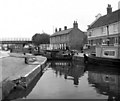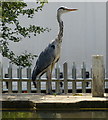
Skew Bridge No 94

There is a bridge here which takes a minor road over the canal.
| Simpson Aqueduct | 6¾ furlongs | |
| Simpson Bridge No 92 | 5 furlongs | |
| Simpson Road Bridge No 92A | 4½ furlongs | |
| Bridge No 93 (Grand Junction Canal) | 3¼ furlongs | |
| Bletcham Way Bridge No 93A | 1½ furlongs | |
| Skew Bridge No 94 | ||
| Fenny Stratford Visitor Moorings | ¾ furlongs | |
| Red Lion PH (Fenny Stratford) | 1¾ furlongs | |
| Fenny Stratford Lock No 22 | 2 furlongs | |
| Fenny Stratford Services | 2¼ furlongs | |
| Fenny Stratford Railway Bridge | 2¼ furlongs | |
- Grand Union Canal Walk — associated with Grand Union Canal
- An illustrated walk along the Grand Union Canal from London to Birmingham
- THE GRAND JUNCTION CANAL - a highway laid with water. — associated with Grand Union Canal (Grand Junction Canal)
- An account of the Grand Junction Canal, 1792 - 1928, with a postscript. By Ian Petticrew and Wendy Austin.
- The Boatmen's Institute in Brentford — associated with Grand Union Canal (Grand Junction Canal - Main Line - Gayton to Brentford)
Mouseover for more information or show routes to facility
Nearest water point
In the direction of Thames - Grand Union Canal Junction
In the direction of Gayton Junction
Nearest rubbish disposal
In the direction of Thames - Grand Union Canal Junction
In the direction of Gayton Junction
Nearest chemical toilet disposal
In the direction of Thames - Grand Union Canal Junction
In the direction of Gayton Junction
Nearest place to turn
In the direction of Thames - Grand Union Canal Junction
In the direction of Gayton Junction
Nearest self-operated pump-out
In the direction of Thames - Grand Union Canal Junction
Nearest boatyard pump-out
In the direction of Gayton Junction
In the direction of Thames - Grand Union Canal Junction
Wikipedia has a page about Skew Bridge
A skew arch (also known as an oblique arch) is a method of construction that enables an arch bridge to span an obstacle at some angle other than a right angle. This results in the faces of the arch not being perpendicular to its abutments and its plan view being a parallelogram, rather than the rectangle that is the plan view of a regular, or "square" arch.
In the case of a masonry skew arch, the construction requires precise stonecutting, as the cuts do not form right angles, but once the principles were fully understood in the early 19th century, it became considerably easier and cheaper to build a skew arch of brick.
The problem of building skew arch masonry bridges was addressed by a number of early civil engineers and mathematicians, including Giovanni Barbara (1726), William Chapman (1787), Benjamin Outram (1798), Peter Nicholson (1828), George Stephenson (1830), Edward Sang (1835), Charles Fox (1836), George W. Buck (1839) and William Froude (c. 1844).






























